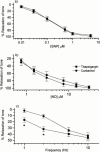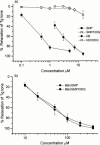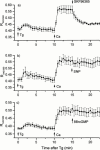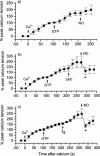Inhibition of capacitative calcium entry is not obligatory for relaxation of the mouse anococcygeus by the NO/cyclic GMP signalling pathway
- PMID: 11181421
- PMCID: PMC1572627
- DOI: 10.1038/sj.bjp.0703888
Inhibition of capacitative calcium entry is not obligatory for relaxation of the mouse anococcygeus by the NO/cyclic GMP signalling pathway
Abstract
1. The object of this study was to determine whether inhibition of capacitative calcium entry is essential for relaxation of the mouse anococcygeus via the NO/cyclic GMP signalling pathway. 2. In intact muscles, thapsigargin (Tg; 100 nM)-induced tone was relaxed by NO, sodium nitroprusside (SNP), 8-Br-cyclic GMP, and nitrergic field stimulation. The relaxations were similar in magnitude to those observed against carbachol (50 microM) tone and, with the exception of those to 8-Br-cyclic GMP, were reduced by the soluble guanylyl cyclase inhibitor 1H-[1,2,4]oxodiazolo[4,3-a]quinoxalin-1-one (ODQ, 5 microM). 3. In single smooth muscle cells, loaded with Fura-2, both carbachol and Tg produced sustained elevations in cytoplasmic calcium levels ([Ca2+]i). SNP inhibited the rise in [Ca2+]i produced by carbachol, an effect attenuated by ODQ. In contrast, neither SNP nor 8-Br-cyclic GMP reduced the elevated [Ca2+]i associated with Tg. 4. In beta-escin skinned preparations, NO had no effect on tone induced by calcium (1 microM in the presence of 100 microM GTP). Carbachol and Tg produced further increases in calcium/GTP-induced tone and, in both cases, this additional tone was relaxed by NO and 8-Br-cyclic GMP. 5. The results support the hypothesis that the NO/cyclic GMP pathway inhibits capacitative calcium entry by refilling the internal stores, since reduction in [Ca2+]i was not observed in the presence of Tg. However, as muscle relaxation was still observed, impairment of capacitative calcium entry cannot be considered obligatory for relaxation. Results from skinned tissues suggest that inhibition of calcium sensitization processes, perhaps associated with store-depletion, may be an important mechanism of NO/cyclic GMP-induced relaxation.
Figures





Similar articles
-
Variable potency of nitrergic-nitrovasodilator relaxations of the mouse anococcygeus against different forms of induced tone.Br J Pharmacol. 1994 Dec;113(4):1494-500. doi: 10.1111/j.1476-5381.1994.tb17165.x. Br J Pharmacol. 1994. PMID: 7889307 Free PMC article.
-
Comparison of two soluble guanylyl cyclase inhibitors, methylene blue and ODQ, on sodium nitroprusside-induced relaxation in guinea-pig trachea.Br J Pharmacol. 1998 Nov;125(6):1158-63. doi: 10.1038/sj.bjp.0702181. Br J Pharmacol. 1998. PMID: 9863642 Free PMC article.
-
Nitrergic relaxation of the mouse gastric fundus is mediated by cyclic GMP-dependent and ryanodine-sensitive mechanisms.Br J Pharmacol. 2000 Apr;129(7):1315-22. doi: 10.1038/sj.bjp.0703174. Br J Pharmacol. 2000. PMID: 10742286 Free PMC article.
-
Inhibition of nitrergic relaxations by a selective inhibitor of the soluble guanylate cyclase.Br J Pharmacol. 1996 May;118(1):137-40. doi: 10.1111/j.1476-5381.1996.tb15376.x. Br J Pharmacol. 1996. PMID: 8733586 Free PMC article.
-
Mechanism of a nitric oxide donor NOR 1-induced relaxation in longitudinal muscle of rat proximal colon.Jpn J Pharmacol. 2001 Aug;86(4):390-8. doi: 10.1254/jjp.86.390. Jpn J Pharmacol. 2001. PMID: 11569612
Cited by
-
Receptor-independent activation of Rho-kinase-mediated calcium sensitisation in smooth muscle.Br J Pharmacol. 2003 Aug;139(8):1532-8. doi: 10.1038/sj.bjp.0705394. Br J Pharmacol. 2003. PMID: 12922941 Free PMC article.
-
Selective inhibition of thapsigargin-induced contraction and capacitative calcium entry in mouse anococcygeus by trifluoromethylphenylimidazole (TRIM).Br J Pharmacol. 2001 Sep;134(2):233-6. doi: 10.1038/sj.bjp.0704286. Br J Pharmacol. 2001. PMID: 11564639 Free PMC article.
References
-
- BAHNSON T.D., PANDOL S.J., DIONNE V.E. Cyclic GMP modulates depletion-activated Ca2+ entry in pancreatic acinar cells. J. Biol. Chem. 1993;268:10808–10812. - PubMed
-
- BIAN X.P., BIRD G. STJ., PUTNEY JNR. J.W. cGMP is not required for capacitative Ca2+ entry in Jurkat T-lymphocytes. Cell Calcium. 1996;19:351–354. - PubMed
-
- CHUANG A.T., STRAUSS J.D., STEERS W.D., MURPHY R.A. cGMP mediates corpus cavernosum smooth muscle relaxation with altered cross-bridge function. Life Sciences. 1998;63:185–194. - PubMed
Publication types
MeSH terms
Substances
Grants and funding
LinkOut - more resources
Full Text Sources
Miscellaneous

